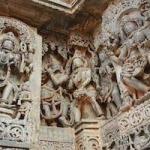
THE RELIGION GUY’S ANSWER:
Nikki Haley, who is challenging Donald Trump for the Republican presidential nomination, was raised in the religion of Sikhism (“SEEK-ism”) by immigrant parents from India. But soon after both Sikh and Methodist weddings she converted to husband Michael’s Christianity.
During Haley’s first run for South Carolina governor in 2010, National Public Radio posted a notably nasty piece by a fellow Indian-American who said “I’m not buying” Haley’s “Christian bit,” noting that “serious churchgoers” and political opponents suspected a “conversion of convenience” in a heavily Protestant state. However, Haley adopted Christianity at age 24 and only entered politics eight years later.
Respect for two faiths
Partners in mixed marriages do have to make a religious choice. Haley has repeatedly professed that she is a Christian believer but respects her family and does not criticize its religious heritage. Though a Methodist churchgoer, she occasionally attends Sikh services and has visited the faith’s holiest sanctuary, the Temple of God in Amritsar, India (known as the Golden Temple because it’s covered in gold leaf).
As a journalist, The Guy has no business examining Haley’s soul, but sees her candidacy as a good opportunity for Americans to learn more about her former faith. Sikhism claims to be the fifth-largest world religion after Christianity, Islam, Hinduism and Buddhism, though it does not evangelize and counts only a modest 30 million adherents. Still, that’s double the global number for Judaism.
Sikhism is by far the youngest of the major world religions. Its homeland is the Punjab region of northern India and adjacent Pakistan. The founder, Guru Nanak (1469-1539), was a married accountant with two sons who had a dramatic encounter with God, whence he proclaimed “there is no Hindu; there is no Muslim” and gathered a following as a spiritual teacher.
Syncretism? Hindu offshoot?
Western scholars often depict Sikhism as a classic example of syncretism (blending of different religions) or a reforming “offshoot” of Hinduism. Sikhs insist theirs is a unique faith all its own. Sikhism does obviously agree with important aspects of older religions, but adds its own concepts, practices and scriptures, creating a unique synthesis as a separate and very cohesive religious community.
Sikhs stand out due to obligatory physical signs of devotion, starting with the turban worn by men and headscarf or turban for women. Most observant Sikh youths and adults undergo initiation into the Khalsa order established by the tenth and final guru in 1699. Members are identified by five signs: keeping hair uncut; carrying a steel bracelet, wooden comb, and sword or dagger representing militancy for justice; and wearing special underpants to evoke sexual purity.
Like Judaism, Christianity and Islam, Sikhism is monotheistic and spurns idols. It believes in the one God who is the creator of everything, eternal, transcendent, all-powerful, all-knowing, self-existent, without form, and ineffable yet self-revealing and knowable by all. Nanak and the nine authoritative gurus who followed him rejected Hinduism’s numerous gods and goddesses, supplanted its caste system with belief in the equality of all men and women, fought the burning of widows, and opposed renunciation of everday life by cloistered devotees.
Reincarnation and Karma
Yet Sikhism does agree with the Hindu (and Buddhist) belief in the cycle of Samsara. Each soul undergoes a long sequence of births, deaths, and rebirths known as reincarnation or the transmigration of souls. Under the law of Karma, accumulated good and evil deeds determine a soul’s status in the next life. A Sikh strives to reach eventual Mukti (liberation from Samsara) in ultimate union with God. At death, a Sikh’s remains are cremated and poured into flowing water.
As for Christian affinity, Sikhism’s calls its Khalsa initiation “baptism.” The new member is not immersed but sprinkled on the head with sweetened water after sipping it from a ceremonial bowl stirred with a sword. Since the death of the tenth guru in 1708, Sikhism’s scripture, the Guru Granth Sahib, has been the source of authoritative teaching, much as in Protestant Christianity. Readings are central for worship ritual, and a ceremonial copy is present in all gurdwaras (congregational houses of worship) and most homes. Notably, the Guru Granth Sahib includes poems by non-Sikhs.
Sikhism’s lifestyle differs from Islam in banning polygamy. It forbids tobacco and alcohol, and otherwise defines virtues and vices in common with most faiths. It advocates love, truthfulness, honesty in business, charity and service toward others, contentment with God-given circumstances, humility, self-control, tolerance, sexual propriety, education and courage. The five primary evils are pride, anger, lust, greed, and materialism (“attachment”).
A notably democratic religion
This notably democratic religion lacks a hierarchy or clergy class. Each gurdwara elects its own functionaries, and any qualified man or woman may lead worship or deliver the discourse on the scriptures. A communal meal (Langar) is an important part of worship gatherings. Four annual holy days commemorate founding gurus. While Islam prescribes five daily prayer times, Sikhism has three, and also encourages moments of meditation on God’s name and nature at other times during the day.
One standard estimate puts America’s Sikh population at 410,000. As of 2021, households of U.S. immigrants from India (Sikhs included) had a median annual income of $150,000, compared with $70,000 for all U.S. households. That same year, 5% of India immigrants were living in poverty, compared with 14% of immigrants over-all and 13% of the native-born.
U.S. Sikhs usually appear in the news when they are under challenge. It’s no coincidence that the Sikh Coalition, which defends the group’s civil rights, was founded on 9-11, correctly anticipating there’d be harassment by people who thought Sikhs were Muslims. In 2012, a white supremacist murdered seven worshippers and wounded others at the gurdwara in Oak Creek, Wisconsin. Last December, Sikhs won a federal appeals court ruling against the U.S. Marine Corps that affirmed men’s right to wear the obligatory turban with uncut hair and beards during basic training. The Army and Air Force had relented previously.
Sikhs suffered terribly during the chaotic separation of India and Pakistan in 1947. Hundreds died in 1984 when Indian troops assaulted the Golden Temple to expel terrorists who occupied the premises and demanded an independent Sikh state of Khalistan. Sikh bodyguards later assassinated Prime Minister Indira Gandhi. Yet Ghandi’s efforts made Zail Singh India’s first Sikh president in 1982. In 2004 a Sikh, Manmohan Singh, became India’s first non-Hindu prime minister.
Further information is available in the Patheos.com library at www.patheos.com/library/sikhism/.











